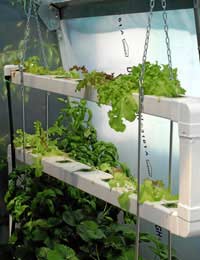
While most of the plants under glass are going to be grown in compost or soil, if you fancy something a little different, the closed environment of the greenhouse offers the perfect chance to dabble with a little small scale hydroponics.
Generally this is a technique used to raise crops commercially – Arizona hosting the world’s largest facility which boasts greenhouses covering 256 acres and sells around 60 million kilos of tomatoes yearly. However, it is perfectly possible for interested amateur gardeners to try their hand at this way of propagation – albeit on a considerably more modest scale!
The basic idea behind hydroponics is very simple and involves growing your plants in nutrient-rich water – a method known as “solution culture”. Some people also include growing in “soil-less” inert media, such as gravel, perlite or rockwool – called “medium culture” – but opinions on whether this really counts as hydroponics are divided and the debate can some times get a little heated! There are a variety of approaches – rejoicing in wonderful sounding names such as static solution culture, continuous flow culture and aeroponics – and a number of different systems available, though they are not all equally suited to the small-scale garden greenhouse.
Getting Started
Although it is perfectly possible to construct your own hydroponic units, probably the easiest way to get started is to buy one of the small starter kits which are available – mostly from specialist outlets and online. There are a few to chose from, but one of the most popular – the Hydro-Greenhouse – only takes up 10 inches x 20 inches of staging space making it a great way to see if you get bitten by the bug. It also has the big advantage that if you do, it can be used to get seedlings started for larger systems later. Designed around a wick-feed which draws the nutrient solution from an integral reservoir, it is an entirely self-contained kit and comes with everything you need to get going, including enough nutrient mix to keep you going for a year – just add your own choice of seeds.
Alternatively, if you favour a more “hands-on” approach, then the wheat-grass juice kit – available from Evergreen Hydroponics – might be a good one to consider. Complete with growing trays, a sprouting jar, nutrients, sufficient organic wheat berries to get you started and a juicer to obtain the product, this is certainly a novel and interesting way to try out the health benefits claimed for this plant extract.
Advantages
Since no soil is used, soil borne diseases are virtually eliminated, root problems are lessened and weeds are seldom a problem – all of which tends to mean that pesticide use can often be substantially reduced. In addition, using a nutrient mixture ensures that the plants get a perfectly balanced feed, with none of the uncertainty that may occur with fertiliser applications, requires less water and by the same token, over- and under-watering is also avoided. With fewer pest problems and nutrients constantly available at root-level, hydroponic systems are highly productive. The small scale hydroponic grower is unlikely to see many of these advantages, however – at least not in the confines of a unit occupying a mere two square feet of bench!
For the majority of greenhouse gardeners, hydroponics is probably destined to remain little more than a slightly unusual diversion from the main business of traditional growing, although some have established quite extensive DIY systems to explore the idea further. For the interested – though less ambitious – amongst us, small off-the-shelf kits probably offer the best way for us to indulge our curiosity and usually come with comprehensive booklets. Hydroponics has a long history – making its first appearance in print in 1627 – and with NASA researching it extensively today for use on future space missions, it is an approach to growing that remains bang up to date. If something a little bit different does appeal, then you only need a couple of square feet to get started.
